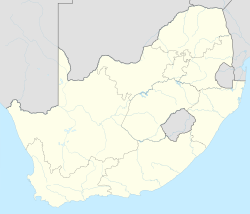District Six
| District Six | ||
|---|---|---|
|
|
||
| Coordinates | 33 ° 56 ′ S , 18 ° 26 ′ E | |
| Basic data | ||
| Country | South Africa | |
| Western cape | ||
| metropolis | City of Cape Town Metropolitan Municipality | |
| ISO 3166-2 | ZA toilet | |
| founding | 1867 | |
|
Barrens in District Six in Cape Town, picture from 2005
|
||
District Six ( Afrikaans Distrik Ses ) is a district in Cape Town, South Africa, defined in this way in 1867 as part of a local government reform . The area was mostly inhabited by freed slaves, traders, artists, workers and immigrants because it was close to the city center and the port.
In the late 1960s, the current multiethnic, cultural center municipality was forcibly evicted and demolished and converted into a residential area for "White" rededicated . The expulsion of the former population is one of the prime examples of the racist politics of the apartheid period . This process was consistent with the "urban resettlement" since 1968 strengthened nationally-driven ( urban relocation ) "non-white" populations related, resulting in a geographically clearer differentiation between the residential areas of "white" and "non-white" residents emerged.
history
When the politics of exclusion became stronger at the beginning of the 20th century , black people in particular had to leave the area. As racial segregation increased, more affluent people moved from District Six to the southern suburbs. The district was considered a multicultural center and attracted numerous artists, such as jazz musicians and painters such as Kenneth Baker, who portrayed the District Six. Based on the Group Areas Act of 1950, the government declared District Six to be a "white zone" in 1966, as allegedly too much crime emanated from the area. In 1968 the government ordered the forced relocation of blacks and coloreds . The district was completely cleared and the houses demolished. The citizens were resettled, depending on their skin color, in the townships in the Cape Flats , a sand plain east of the city at that time. By 1982 over 60,000 people had been displaced from District Six. The area should be populated by whites, but remained undeveloped for a long time.
In 2003, nine years after the official end of apartheid, the government had 24 new houses built. On February 11, 2004, Nelson Mandela gave the old returnees Ebrahim Murat and Dan Ndzabela the first keys. In 2005 the land was completely surveyed and the newly built houses assigned. The area is still partly wasteland today, but some areas belong to the districts of Zonnebloem or Walmer Estate and are repopulated. Gradually, a “new” District Six is to be created.
aftermath
The South African writer Alex La Guma , who was born there, created a literary memorial for District Six with his short novel A Walk in the Night (1962).
The District Six Museum, opened in 1994 at 25 Buitenkant Street in Cape Town, offers an insight into people's lives before the demolition.
Musically reminiscent of the District Six Brian Abrahams with his band of the same name, which includes jazz musicians like Mervyn Africa , Chris McGregor , Jim Dvorak, Dill Katz and later Steve Lodder , Louise Elliot and Hilton Schilder .
In 1986 the musical District 6 - The Musical , written by David Kramer and Taliep Petersen, premiered. It has been performed in numerous countries. That same year, Richard Rive's book Buckingham Palace, District Six was published , which describes life before and after the eviction from District Six.
The science fiction film District 9 is inspired by the district and the events of the apartheid period.
Web links
- Cape Town-Journey of Remembrance. A political and historical tour of District Six and the Cape Flats; led by opponents of apartheid and former resistance fighters
- Description of District Six (English)
- District Six Museum Museum website
Individual evidence
- ^ Gerry Maré: African Population Relocation in South Africa . Johannesburg 1980, p. 25


